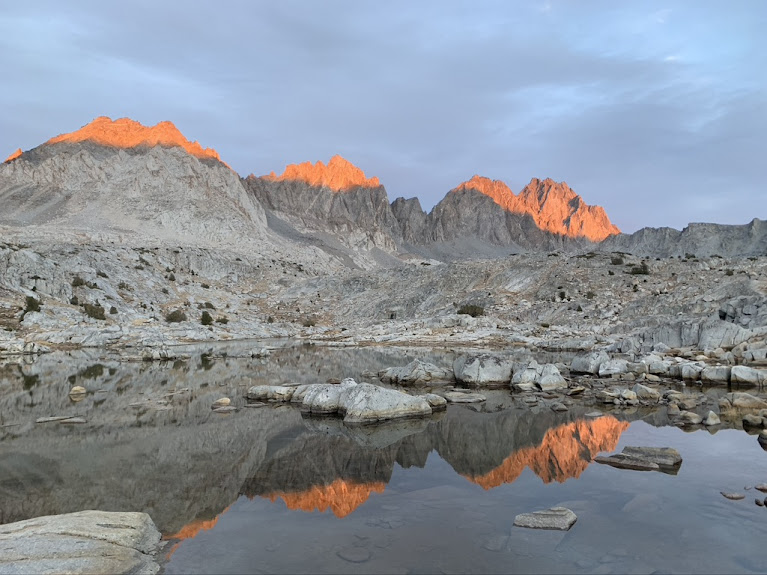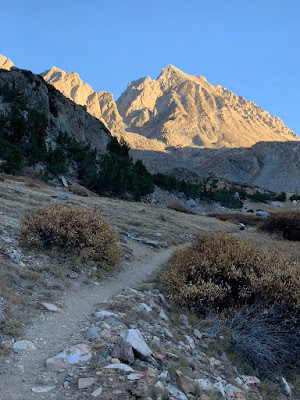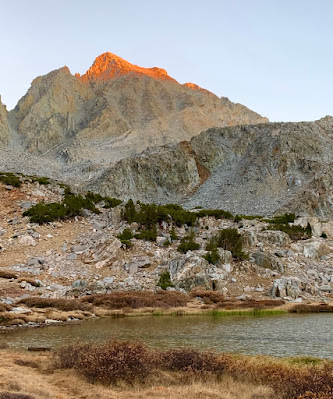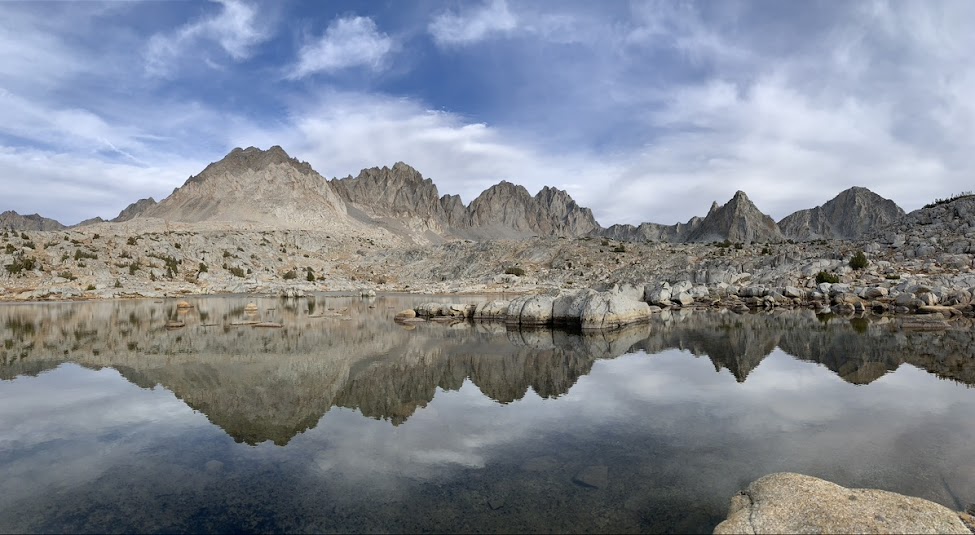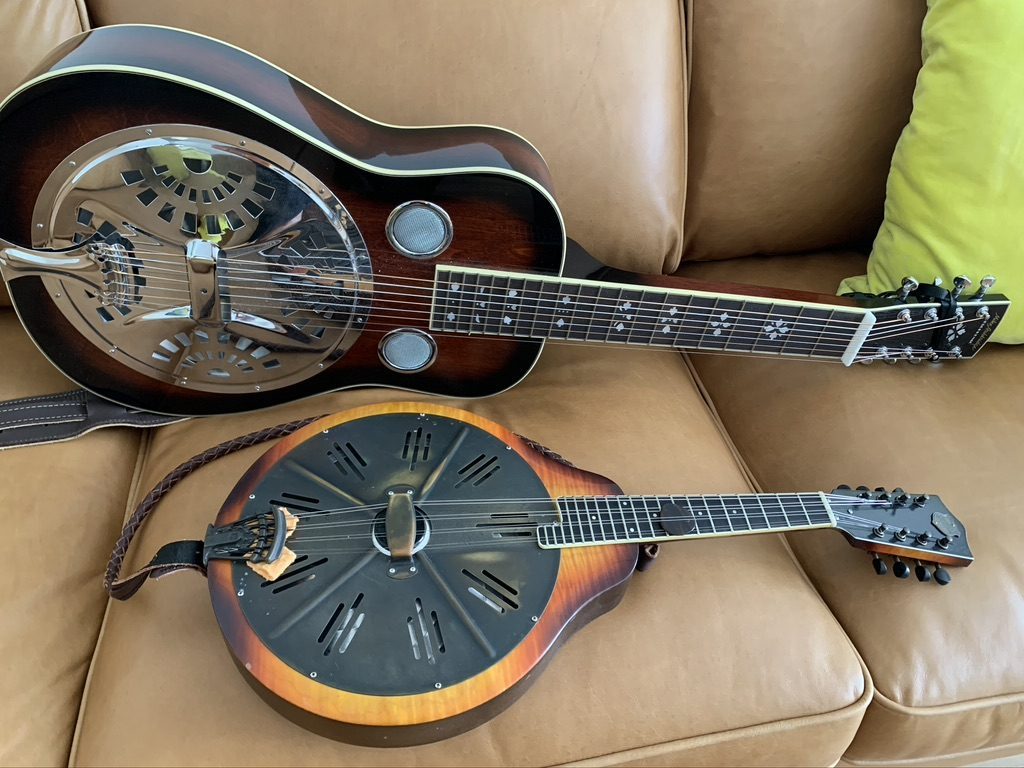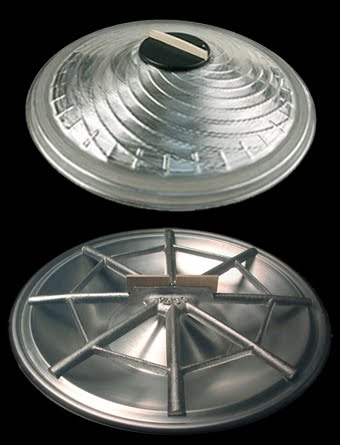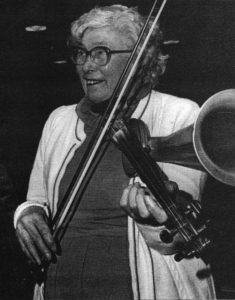 |
| Sixty Lake Basin |
Four days in the High Sierra
The Eastern Sierras are within easy reach from LA, about 4 hours to trailheads and offer an amazing alpine scenery that never disappoints. No matter how much further you want to travel, it won't get any better. The downside is that trails can be congested, especially the (deservedly famous) John Muir Trail or Rae Lakes loop. However, combined with some cross-country (no trail) hiking I had many hours without encountering anybody.
I left Santa Monica at noon and was on the Kearsarge Pass trail a little after 4 pm. It was a thundery afternoon and got a bit drizzled on. Actually perfect as the clouds and drizzle kept the temperature down. Otherwise, this could be a really hot climb. I need about 3 hours to get to Kearsarge Pass, it always is a very hard ascent, even if the temperature is pleasant. On paper, Kearsarge Pass doesn't look as hard as it feels, about 7.5 km and 800 m, but it wrecks me everytime. Maybe because of the altitude coming from sea level? Kearsarge Pass is 3600 m high after all. I also had a heavy backpack this time as I packed for 5 days. Whatever it is, Kearsarge Lakes, just about 2 km downhill from the pass, make a good first destination. Last year, Kathy and I just did that part, more detail (and John Muir quotes) here: https://rolandsturm.blogspot.com/2021/06/eastern-sierras.html
 |
| going up Kearsarge Pass trail on a cloudy afternoon |
 |
| This root sculpture is still a living tree! University Peak on the left |
There is no easy way to get past the mountain barrier on the eastern end, only strenuous ones. Kearsarge Pass Trail is easier and shorter than the others, Baxter, Sawmill, or Taboose, are twice the effort because they start much lower. Sawmill is 20km long with 2000m of gain. Kearsarge is 7.5 km and 800 m of gain. It comes at the price of extreme popularity, including people with their dogs, which is most annoying during the first half up to Flower lake. Then it thins out a bit and the other side of the pass is Kings Canyon National Park where pets aren't allowed.
 |
| Sunset at the 3rd Kearsarge Lake |
 |
| Sunrise at the 3rd Kearsarge Lake |
The next morning, I connected with the John Muir Trail (JMT) going north towards Rae Lakes and by noon was over Glenn Pass, also around 3600m, but only 400m of gain. It still is a hard climb with a big pack.
 |
| Bullfrog lake on the left |
 The John Muir Trail and Rae Lakes loop are well known and extremely popular. Too many people all looking for solitude and remoteness! If you look at maps, the Rae Lakes loop goes around the Gardiner Basin and 60 Lake Basin, mostly along creeks/rivers. On the west, it is the South Fork of the Kings river, on the north Woods Creek, on the south Bubbs Creek, on the east Rae Lakes. In the middle are two basins with lots of lakes, but there are no maintained trails there. The two big peaks separating the Gardiner and 60 Lakes basins are Mt Clarence King and Mt Gardiner. They can be connected via 60 Lakes Col. So that's where I headed this time.
The John Muir Trail and Rae Lakes loop are well known and extremely popular. Too many people all looking for solitude and remoteness! If you look at maps, the Rae Lakes loop goes around the Gardiner Basin and 60 Lake Basin, mostly along creeks/rivers. On the west, it is the South Fork of the Kings river, on the north Woods Creek, on the south Bubbs Creek, on the east Rae Lakes. In the middle are two basins with lots of lakes, but there are no maintained trails there. The two big peaks separating the Gardiner and 60 Lakes basins are Mt Clarence King and Mt Gardiner. They can be connected via 60 Lakes Col. So that's where I headed this time.
Going north on the JMT over Glenn Pass, I turned off the trail about halfway down (200 m down from the top, to Rae Lakes would be another 200m of descent).
 |
| View from Glenn Pass, Rae Lakes are on the right further down and you can see the valley where the JMT runs. The 4 or 5 lakes on the left are off the trail, up from there and over the ridge on the left outside the picture gets into 60 Lakes. |
 |
Off the beaten path. From this lake, the long one one on the left in the previous picture, I am trying to find a way over Rae Col to 60 lakes.
|
 |
| Wasn't too difficult to find a way to the top, this is going down the other side. A bit steeper, but not too hard either. |
 |
| Steep scree slope and then some talus rock hopping to lake 3353 |
As soon as I turned off the trail, there were no more people. I saw a Sierra Nevada bighorn sheep, though. Only a tiny fraction of people like to travel cross-country and then they disperse very quickly when there are no trails. In any event, I didn't encounter anybody until I would rejoin the JMT. Lots of pretty lakes here and now truly remote, making it much more attractive to me than Rae Lakes just one or two ranges east from here.
 |
Halfway down to lake 3353
|
Most lakes or peaks don't have names and are labeled with the elevation on USGS topo maps. The topo maps use meters, but older descriptions may be in feet from older topo maps. In any event, lake 3353 is the first one descending via Rae Col into 60 Lake Basin, lake 3304 is towards 60 Lake Col that links the two basins and the first lake on in Gardiner Basin would be 3477 (very rocky area and hard to get around) before dropping to lake 3214. Nowhere as poetic Bullfrog or Arrowhead along the established trails (they have labels, too: Bullfrog is 3234, Arrowhead 3137, middle Rae Lake 3212), but more informative what it takes to get there.


Mosquitoes were mixed. Mid-July is about peak season for them and there were some bad spots, but also many where they were completely absent. Two nights I didn't have any problems, even sitting by the lake during sunset. One night I had to get into the tent by 5pm. During the day, sometimes I had to change plans when to take a break, but always found a mosquito free area. It is possible to leave Gardiner via King Col, it is mentioned in RJ Sector's book "The High Sierras" as a class 2, but then found reports that this was sketchy. The north side supposedly has a snow cornice, an overhanging mass of hardened snow at the edge of a precipice, year round. I was alone nor prepared for anything beyond hiking. Certainly wouldn't want to get close to a cornice. Instead, I took the easy route out from 60 Lakes via Basin Notch.
 |
| Mt. Cotter and Mt. Clarence King |
 |
| It became bright again after midnight with a full moon, with its reflection in a lake |
 |
| Connecting back with the JMT via Basin Notch at Arrowhead Lake, nothing too difficult here, although I had to backtrack once |
 |
Rae Lakes
|
 |
| Fin Dome separates Rae Lakes and Sixty Lakes, a landmark from both sides (this picture has Rae Lakes in the foreground). |
 |
| Painted Lady is next to the first Rae Lake. Going south, this is where the climb to Glenn Pass starts again |
 |
Mt. Rixford (3928 on USGS topo maps)
|
 |
| Still struggling with Glenn Pass |
That afternoon became very wet and it rained for several hours, repeated thunderstorms. Unlike my bike trip last month where I got very chilled with a 20 min storm, this time I didn't even add another layer. It was not exactly comfortable, but not particularly unpleasant although I was wet for 3-4 hours. By 5, the sun came out again and it became almost too warm. I returned to Kearsarge Lakes for the night and the next morning hiked out.
 |
| Kearsarge Lakes and Pinnacles |
